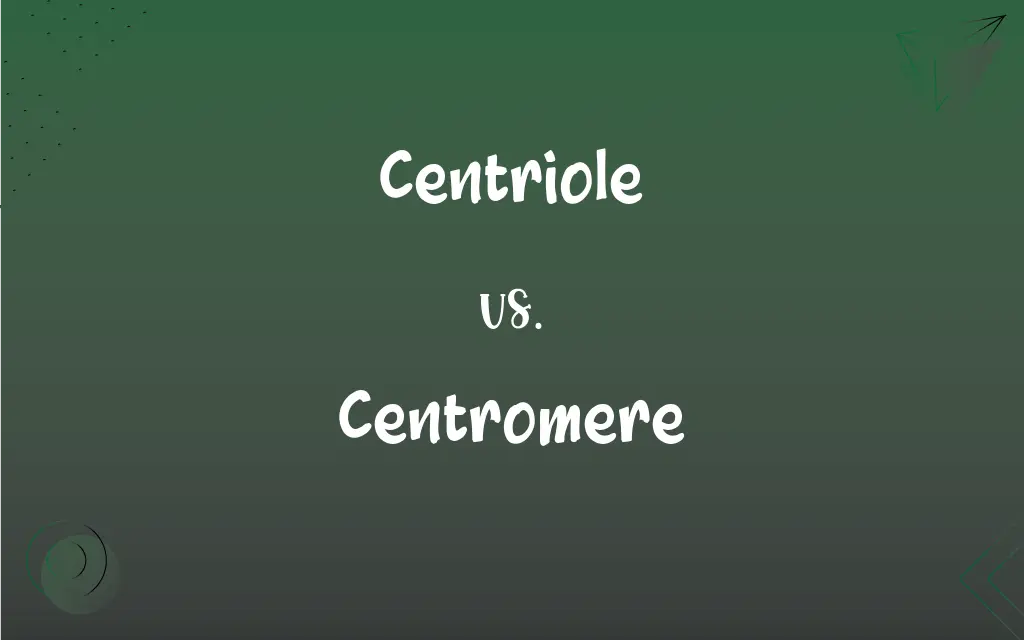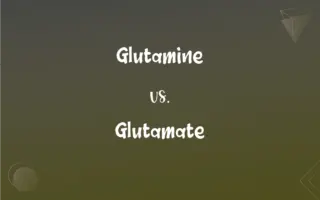Centriole vs. Centromere: What's the Difference?
Edited by Aimie Carlson || By Harlon Moss || Published on December 23, 2023
Centrioles are cylindrical cell structures involved in cell division and organization of microtubules, while centromeres are specific DNA sequences on chromosomes where spindle fibers attach during cell division.

Key Differences
Centrioles are cylindrical organelles found in most eukaryotic cells, playing a crucial role in the formation of spindle fibers during cell division. In contrast, centromeres are specific regions on chromosomes, consisting of unique DNA sequences that serve as attachment points for spindle fibers, crucial for the equal distribution of chromosomes during cell division.
Structurally, centrioles are composed of a group of microtubules arranged in a specific pattern, usually nine groups of microtubules forming a ring. Centromeres, however, do not have a standard structural composition but are identified by specific DNA sequences and associated proteins, forming a constriction point on the chromosome.
Functionally, centrioles are involved in the process of organizing the cell's cytoskeleton and are key components in the formation of cilia and flagella. In contrast, centromeres play a vital role in chromosome segregation, ensuring that each daughter cell receives an equal number of chromosomes during cell division.
During cell division, centrioles migrate to opposite poles of the cell, aiding in the formation of the mitotic spindle. On the other hand, centromeres bind to spindle fibers through kinetochores, a protein complex, ensuring the chromosomes are aligned and segregated properly.
In terms of evolutionary significance, centrioles are believed to have originated in the last eukaryotic common ancestor, being present in most eukaryotic cells. Centromeres, while universally crucial for chromosome segregation, show a high degree of variation in sequence and structure across different species.
ADVERTISEMENT
Comparison Chart
Location
In the cytoplasm, near the nucleus.
On the chromosome, at the primary constriction.
Structure
Cylindrical, composed of microtubules.
Region with specific DNA sequences and proteins.
Function
Organizes microtubules, assists in cell division.
Attachment point for spindle fibers, aids chromosome segregation.
Role in Cell Division
Forms spindle fibers, migrates to poles.
Binds to spindle fibers through kinetochores.
Presence in Cells
Found in most eukaryotic cells.
Present on every chromosome.
ADVERTISEMENT
Centriole and Centromere Definitions
Centriole
A centriole is a small, cylindrical cell structure involved in cell division and cilia formation.
During mitosis, the centrioles move to opposite ends of the cell to help organize the spindle fibers.
Centromere
A centromere is a region on a chromosome that links sister chromatids and is essential for their proper separation during cell division.
The centromere ensures that each daughter cell receives one chromatid from each chromosome during mitosis.
Centriole
Centrioles are composed of microtubules arranged in a distinct pattern, crucial for cellular organization.
The centriole’s unique microtubule arrangement is essential for its role in cell division.
Centromere
Centromeres are characterized by specific DNA sequences and proteins, forming a constriction on the chromosome.
The centromere's unique DNA sequence is crucial for the binding of kinetochore proteins.
Centriole
Centrioles are involved in organizing the cell's cytoskeleton and are a central component of centrosomes.
In the absence of centrioles, the cell's cytoskeleton and division processes can be severely disrupted.
Centromere
The centromere acts as an attachment point for spindle fibers, facilitating chromosome movement during cell division.
Spindle fibers attach to the centromere’s kinetochore to pull chromosomes apart.
Centriole
Centrioles play a key role in the formation of the mitotic spindle during cell division in eukaryotic cells.
The centriole duplicates before cell division to assist in forming the spindle apparatus.
Centromere
Centromeres play a critical role in ensuring accurate chromosome segregation and genetic stability in cells.
Errors in centromere function can lead to aneuploidy, a condition of abnormal chromosome numbers.
Centriole
In cell biology, a centriole is an organelle that serves as an anchor point for microtubules in the cell.
The centriole’s position determines the orientation of microtubules and subsequently the direction of cell division.
Centromere
The structure and function of centromeres vary widely among different organisms, reflecting evolutionary diversity.
The centromere's position and size can differ significantly between species, illustrating its evolutionary adaptability.
Centriole
One of two cylindrical cellular structures that are composed of nine triplet microtubules and form the asters during mitosis.
Centromere
The most condensed and constricted region of a chromosome, to which the spindle fiber is attached during mitosis.
Centriole
(biology) A barrel-shaped microtubule structure found in most animal cells, important in the process of mitosis (nuclear division).
Centromere
(genetics) The central region of a eukaryotic chromosome where the kinetochore is assembled.
Centriole
One of two small cylindrical cell organelles composes of nine triplet microtubules, which form the asters during mitosis.
Centromere
A specialized condensed region of a chromosomes that appears during mitosis where the chromatids are held together to form an X shape.
Centriole
One of two small cylindrical cell organelles composes of 9 triplet microtubules; form the asters during mitosis
Centromere
A specialized condensed region of each chromosome that appears during mitosis where the chromatids are held together to form an X shape;
The centromere is difficult to sequence
FAQs
What is a centriole?
A centriole is a cylindrical cell structure involved in organizing microtubules and facilitating cell division.
Are centrioles present in all cells?
Centrioles are found in most eukaryotic cells, but some cells, like mature mammalian red blood cells, lack them.
Can centromeres be seen under a microscope?
Yes, centromeres can be observed under a microscope as a constriction on chromosomes during certain stages of cell division.
What is a centromere?
A centromere is a region on a chromosome that links sister chromatids and is crucial for chromosome segregation during cell division.
Are centrioles unique to animals?
No, centrioles are found in many eukaryotic cells, not just in animals.
Is the centromere position always central?
No, centromeres can be centrally located (metacentric) or at one end (acrocentric) of a chromosome.
How does the centromere contribute to genetic stability?
By ensuring accurate chromosome segregation, the centromere maintains genetic stability during cell division.
Do centrioles have a role in non-dividing cells?
Yes, centrioles are also involved in the formation of cilia and flagella in non-dividing cells.
What happens if a centromere is damaged?
Damage to a centromere can lead to improper chromosome segregation, potentially causing genetic disorders.
Can centrioles form without centrosomes?
Yes, centrioles can form independently of centrosomes, although they are often associated with them.
Are centromeres involved in meiosis?
Yes, centromeres play a crucial role in the proper segregation of chromosomes during meiosis.
Are centromeres genetically coded?
Centromeres are defined by specific DNA sequences and associated proteins, which are genetically determined.
What is the role of centrioles in mitosis?
Centrioles help in forming the spindle apparatus that segregates chromosomes during mitosis.
How do centrioles replicate?
Centrioles replicate during the cell cycle's S phase, forming a new centriole adjacent to each existing one.
Can centrioles be duplicated independently of the cell cycle?
No, centriole duplication is tightly regulated and occurs in coordination with the cell cycle.
Is the centromere's function affected by its position?
The position of the centromere affects the shape of the chromosome but not its fundamental function in cell division.
Can centromere function be studied in the lab?
Yes, the function and structure of centromeres are studied using various molecular biology
Are centromeres conserved across species?
Centromere DNA sequences and structure can vary widely among different species.
Are there diseases associated with centriole dysfunction?
Yes, defects in centriole function are associated with various diseases, including cancer and ciliopathies.
Do plant cells have centrioles?
Most plant cells lack centrioles, relying on other structures for cell division.
About Author
Written by
Harlon MossHarlon is a seasoned quality moderator and accomplished content writer for Difference Wiki. An alumnus of the prestigious University of California, he earned his degree in Computer Science. Leveraging his academic background, Harlon brings a meticulous and informed perspective to his work, ensuring content accuracy and excellence.
Edited by
Aimie CarlsonAimie Carlson, holding a master's degree in English literature, is a fervent English language enthusiast. She lends her writing talents to Difference Wiki, a prominent website that specializes in comparisons, offering readers insightful analyses that both captivate and inform.
































































